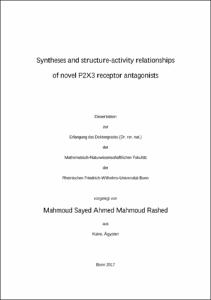Rashed, Mahmoud Sayed Ahmed Mahmoud: Syntheses and structure-activity relationships of novel P2X3 receptor antagonists. - Bonn, 2018. - Dissertation, Rheinische Friedrich-Wilhelms-Universität Bonn.
Online-Ausgabe in bonndoc: https://nbn-resolving.org/urn:nbn:de:hbz:5n-50431
Online-Ausgabe in bonndoc: https://nbn-resolving.org/urn:nbn:de:hbz:5n-50431
@phdthesis{handle:20.500.11811/7547,
urn: https://nbn-resolving.org/urn:nbn:de:hbz:5n-50431,
author = {{Mahmoud Sayed Ahmed Mahmoud Rashed}},
title = {Syntheses and structure-activity relationships of novel P2X3 receptor antagonists},
school = {Rheinische Friedrich-Wilhelms-Universität Bonn},
year = 2018,
month = apr,
note = {P2X3 receptors are ligand-gated ion channels activated by extracellular adenosine-5’-triphosphate (ATP). Activation of the P2X3 receptors has been linked to several pathophysiological conditions including inflammation and pain. Because of the (patho)physiological role of the P2X3 receptors, compounds that block the receptor have potential as novel drugs.
This study was aimed at synthesizing and developing potent and selective P2X3 receptor antagonists with a focus on two distinct classes of compounds that have been identified as P2X3 receptor antagonists in a screening approach, anthraquinone (AQ) derivatives and compounds related to triphenylmethanes.
A sub-project was focused on establishing a synthetic approach for derivatives bearing non-acidic functionalities at the 2-position of the AQ scaffold, especially 1-amino-4-(ar)alkylaminoanthraquinone derivatives bearing a 2-methyl group. The previously synthesized AQ derivatives, which have been developed as selective and potent antagonists for different P2 receptors all contained a sulfonate group (SO3-) at the 2-position. Ullmann coupling of 1-amino-4-bromo-2-methyl-AQ with amines/anilines was applied to obtain the 4-substituted final products. Reaction conditions had to be optimized. The use of a mixture of copper(0), and copper(II) acetate monohydrate as a catalyst was required for obtaining good yields. Various anthraquinone derivatives were synthesized and tested for their inhibitory activity at P2X3 and other P2 receptor subtypes. The best P2X3 antagonist of the present series was 1-amino-2-methyl-4-(4-phenylamino-3-sulfophenylamino)anthracene-9,10-dione with an IC50 of 3.07 μM at the human receptor. We found that 2-methyl-AQ derivatives are selective versus P2Y receptors due to the lacking of a charged group in the 2-position, which is required for interaction with P2Y receptors.
Another sub-project focused on triphenylmethane derivatives, which were recently shown by our laboratory to block P2X3 receptors. In the present study, structure-activity relationships were explored by synthesizing derivatives and analogs of the hit compound. In addition, related dibenzopyranone derivatives were obtained. This structure was found to lead to the most potent P2X3 receptor antagonist of the present series with an IC50 of 0.121 μM at the human receptor, being 3-fold more potent than the lead structure. A pharmacophore model was subsequently developed to provide a basis for further improvement.
The newly identified P2X3 receptor antagonists represent a promising class of novel therapeutics to control inflammation and disease states associated with pain.},
url = {https://hdl.handle.net/20.500.11811/7547}
}
urn: https://nbn-resolving.org/urn:nbn:de:hbz:5n-50431,
author = {{Mahmoud Sayed Ahmed Mahmoud Rashed}},
title = {Syntheses and structure-activity relationships of novel P2X3 receptor antagonists},
school = {Rheinische Friedrich-Wilhelms-Universität Bonn},
year = 2018,
month = apr,
note = {P2X3 receptors are ligand-gated ion channels activated by extracellular adenosine-5’-triphosphate (ATP). Activation of the P2X3 receptors has been linked to several pathophysiological conditions including inflammation and pain. Because of the (patho)physiological role of the P2X3 receptors, compounds that block the receptor have potential as novel drugs.
This study was aimed at synthesizing and developing potent and selective P2X3 receptor antagonists with a focus on two distinct classes of compounds that have been identified as P2X3 receptor antagonists in a screening approach, anthraquinone (AQ) derivatives and compounds related to triphenylmethanes.
A sub-project was focused on establishing a synthetic approach for derivatives bearing non-acidic functionalities at the 2-position of the AQ scaffold, especially 1-amino-4-(ar)alkylaminoanthraquinone derivatives bearing a 2-methyl group. The previously synthesized AQ derivatives, which have been developed as selective and potent antagonists for different P2 receptors all contained a sulfonate group (SO3-) at the 2-position. Ullmann coupling of 1-amino-4-bromo-2-methyl-AQ with amines/anilines was applied to obtain the 4-substituted final products. Reaction conditions had to be optimized. The use of a mixture of copper(0), and copper(II) acetate monohydrate as a catalyst was required for obtaining good yields. Various anthraquinone derivatives were synthesized and tested for their inhibitory activity at P2X3 and other P2 receptor subtypes. The best P2X3 antagonist of the present series was 1-amino-2-methyl-4-(4-phenylamino-3-sulfophenylamino)anthracene-9,10-dione with an IC50 of 3.07 μM at the human receptor. We found that 2-methyl-AQ derivatives are selective versus P2Y receptors due to the lacking of a charged group in the 2-position, which is required for interaction with P2Y receptors.
Another sub-project focused on triphenylmethane derivatives, which were recently shown by our laboratory to block P2X3 receptors. In the present study, structure-activity relationships were explored by synthesizing derivatives and analogs of the hit compound. In addition, related dibenzopyranone derivatives were obtained. This structure was found to lead to the most potent P2X3 receptor antagonist of the present series with an IC50 of 0.121 μM at the human receptor, being 3-fold more potent than the lead structure. A pharmacophore model was subsequently developed to provide a basis for further improvement.
The newly identified P2X3 receptor antagonists represent a promising class of novel therapeutics to control inflammation and disease states associated with pain.},
url = {https://hdl.handle.net/20.500.11811/7547}
}






